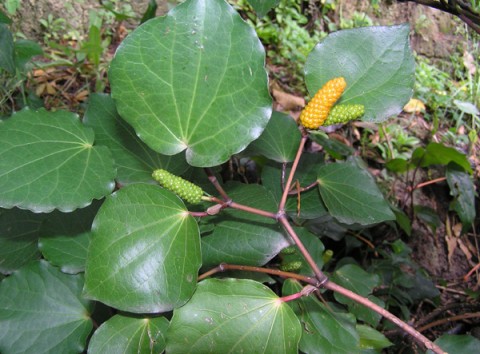Native born remedies
Guest Blogger: Ethnobotanist at Landcare Research, Sue Scheele
Over the next few months, Sue Scheele will write a series of blogs on the medicinal uses of our home-grown plants. First up, the ubiquitous kawakawa – cough clearer, tooth-ache reliever and headache buster. Over to you Sue!
Take a quick look at the shelves of your pharmacy or supermarket and you’ll find a myriad of herbal remedies for common ills.
A closer inspection however will reveal these products are mostly derived from introduced plants, which have a long history of medicinal use in Europe.
But that’s not to say that our native plants don’t have the therapeutic properties of their European cousins.
For instance, Murdoch Riley’s book “Maori Healing and Herbal” (1994, Viking Sevenseas) has over 500 pages of medicinal information, reflecting the depth of Maori knowledge developed over centuries of observation and use.
Some of these plant remedies are still widely used today, by both Maori and pakeha, and the ritual and spiritual aspects remain relevant in Maori communities.
But whether we use them or not, I think knowing about their special properties enriches our experience of native plants, and provides another reason to work to halt the loss of biodiversity in Aotearoa.
And who knows, in a time of economic melt-downs, and the looming end of the fossil-fuel era, when we might need all the info we can get on using our special plants……
Kawakawa (Macropiper excelsum, or pepper tree)
Kawakawa is an easily recognized shrub, with aromatic, heart-shaped leaves, that grows widely in coastal lowlands, as far south as Christchurch. It’s a lovely garden plant in areas that are free of hard frosts.
A look at the leaves of kawakawa gives us a clue as to why the first arrivals here from Polynesia called it that. The leaves are like its relative, kava (Piper methysticum), used widely in the South Pacific as a ceremonial drink. Kava has a mild narcotic effect.
Kawakawa doesn’t have those properties, but the spicy leaves are highly valued for relieving bronchial complaints. Boil a handful of the fresh, young leaves in a small saucepan of water for 15-20 minutes, then drink half a cup of the liquid to relieve chesty coughs. To make a pleasant tea, for use as a general tonic, it’s best to dry the leaves first, then use a small quantity in a teapot. It’s very good for relieving indigestion.
The flesh of the ripe orange fruits is quite sweet, but if you bite the seeds, the flavour is too pungent. The fruits and leaves were chewed for toothache – swallow the saliva and keep the leaf matter in your mouth for some time. (The active ingredient is myristicin, which is related to eugenol, a dental analgesic)
The leaves can be put into hot water, bruised, then used as a poultice on cuts, boils and sores, bruises and to relieve neuralgic (head & face) pain. Kawakawa leaves were commonly used in steam baths for rheumatic and arthritic pains.

